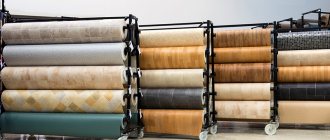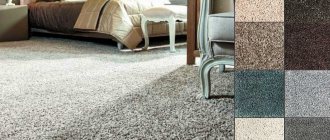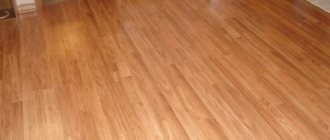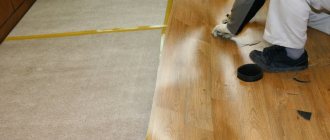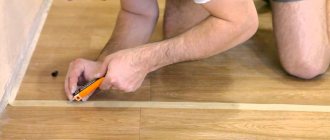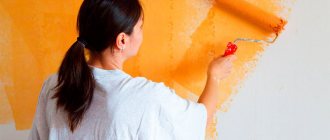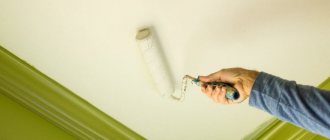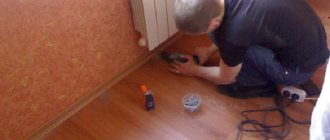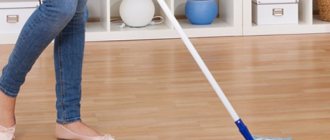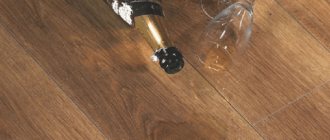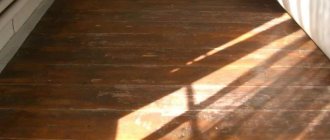The smooth and therefore slippery surface of linoleum flooring is not the best base for laying carpet. Despite all the advantages and high comfort, carpeting causes a lot of trouble. Therefore, the idea of laying carpet on linoleum can be considered as a worthy replacement for the classic carpet covering.
You can cover the entire floor with carpet
Is it possible to lay carpet on linoleum
From a technological point of view, there are no restrictions on laying one coating on top of another. Another thing is a carpet substitute, which has a small thickness and a specific texture on the back side, so carpet can be laid on linoleum only under the following conditions:
- There is no damage, peeling areas, holes, or cuts on the linoleum surface. The condition of the linoleum must be at least a “C” grade, otherwise all defects will appear through the carpet fabric, or even worse, lead to tears in the textile base;
- The floor surface must be level with the horizon, otherwise even the glued carpet will be torn off from the base over time. You can lay carpet on linoleum and fix its position with glue or an additional system of fasteners, but the coating will not look smooth and beautiful.
Simply replacing carpet with linoleum instead of carpet will not provide the desired effect. First of all, you need to fix the canvas over the entire surface of the floor to avoid the effect of the material sliding under the feet of residents.
Long pile material
Details
How to make the right choice
You will be able to make a choice which is better - carpet or linoleum in the apartment without any problems if you know about the functional purpose of a certain room. For example, if the ideas are about rooms where frequent wet cleaning is expected, where the floor covering is regularly exposed to the possibility of being damaged and its repair work is needed, then the choice is obvious - only linoleum.
If we talk about the selection of coverings for public places, then we should also understand their functional type. Premises that will be visited by a huge number of people at the same time, where wet cleaning often needs to be carried out for disinfection, are definitely worth covering with linoleum.
Please note that rooms that require the creation of a pleasant and comfortable atmosphere where you plan to spend a lot of time will benefit from being lined with carpet. https://www.youtube.com/embed/JlG5ewNhgQA
Recommendations from professionals
It is impossible to make a competent choice based on only one of the criteria. When determining whether to lay carpet or rolled linoleum, you need to remember that they both can be of different thicknesses and differ in quality. The denser and thicker the carpet, the longer it will last. The same recommendations can be given when selecting a material such as linoleum.
Helpful advice! When choosing a carpet, you need to remember that, like any carpet, under long-term mechanical influence it can form bald patches, which negatively affects its overall appearance.
Carpet in the bedroom helps make the room more comfortable and warm. When choosing carpet, for example, in an office space, you should give preference to the least fleecy and thick specimens.
How to properly lay carpet on linoleum
The basis of the carpet fabric is a dense jacquard weave made of polyester and polypropylene threads. This material glides moderately on plank floors, OSB and chipboards, but if you put carpet on linoleum, the coating becomes uncontrollable. Therefore, the carpet fabric, which is planned to be laid on linoleum or varnished parquet, is hemmed on the back side with rubberized tapes or edgings with silicone inserts. This reduces carpet slipping, but is not effective enough.
For a relatively new floor, you most often have to lay carpet on linoleum using standard methods of attaching the material:
- Stick the canvas to the floor using double-sided tape. Even a teenager can install carpet with tape. You just need to choose the right places to lay the adhesive strip;
- A more reliable method is to lay the synthetic coating on an adhesive base. Installation will require special preparation of the back side of the carpet;
- Fixing and stretching of material on mounting rails, also called stretching.
They often try to fix carpet on linoleum using heavy furniture, using special lacing through hooks on the baseboards. It turns out to be effective, but not always aesthetically pleasing and beautiful.
Important! The fairly rigid structure of the carpet requires a perfect fit of the covering to the linoleum.
Therefore, the canvas must be laid on a separate, independent type of fastener, independent of the arrangement of heavy furniture in the room. If the material is fixed and not tensioned evenly enough, then waves will certainly appear on the panel, or as a result of uneven wear, entire tracks of worn-out textiles will form.
A correctly laid covering is not even perceived as fabric
Is it possible to lay carpet on an adhesive backing?
The use of glue is, of course, an additional cost. But of all the options listed, the idea of laying carpet on linoleum using an adhesive composition looks the most convincing:
- Good glue does not lose its fixing ability even after 10 years of use;
- The width, area and location of the adhesive spot can be chosen at your discretion.
Of course, laying carpet with glue will require much more effort and time than if you used adhesive tape, but you can be sure that the fastening will not be torn off, and the coating will safely survive until the end of its service life.
Stretching remains the most difficult and problematic. In order to install mechanically fastened carpet using strips and rivets built into the floor, you need experience and costs that are an order of magnitude higher than the cost of buying a can of good glue.
Benefits of Scotch tape
The first experience in laying carpet on linoleum will always be tape. Sometimes apartment owners themselves prefer to lay the material on adhesive tape, only to make sure how correct the choice in favor of this carpet model was.
You can also try installing the covering with adhesive tape due to the fact that it is minimal labor and cost. True, you will have to change the tape at least once a year.
Parquet: advantages and disadvantages
Parquet or parquet board is the cleanest and most practical material
Parquet or parquet board is the cleanest and most practical material that requires careful handling. With proper care, parquet will last for decades. Made from natural wood, the flooring is distinguished by its excellent aesthetics, practicality and versatility: a good parquet will elevate even a small apartment, you just have to choose it correctly. You can, of course, lay parquet in the kitchen, hallway or on the balcony, but the price and difficulty of maintenance will certainly make you think: good parquet does not come cheap, so the cost of the product starts from $150 per m2.
And now about the advantages:
- Naturalness, environmental friendliness;
- Aesthetics and warmth of natural wood;
- Durability;
- The uniqueness of the design of each element;
- Strength. Parquet doesn’t mind even serious blows, of course, if it’s a natural wood board;
- Variety of colors and shapes.
The coating has many disadvantages:
- Difficulty of care. Cycling, rubbing, oiling - all these procedures are necessary to keep the floor looking beautiful;
- High price;
- Requirement for surface evenness before installation;
- Maintaining a certain temperature and humidity in the room, otherwise the parquet will dry out and begin to creak;
- Not resistant to scratches. If pinpoint impacts do not cause harm, then moving furniture or even putting it in place without special spacers is not recommended.
How to prepare the surface for laying carpet on linoleum
No special preparation of the linoleum surface is required. Usually, before starting work, a small calculation is made on the amount of material and markings are made for applying the adhesive material.
Of course, the strips on the linoleum on which you plan to lay tape or glue must be thoroughly washed and cleaned of any dirt. The surface for laying the adhesive tape should be perfectly smooth, but for glue it is best to get rid of the gloss on the surface. This can be done using a sanding pad and a small amount of water.
The main thing is not to forget to put markings on the floor along which the adhesive base will be laid, otherwise you can lay the material with errors. Any attempt to tear off the carpet after installation will significantly reduce the quality of the fasteners.
Cutting is carried out strictly according to the room plan
Preparing the room
Carpet is quite capricious in terms of storage, transportation and installation conditions. First of all, this concerns air temperature and humidity. Before you begin laying carpet in your apartment, make sure that the room:
- approximately the same humidity and air temperature remain for at least three days;
- There are no sudden changes during the day.
Before laying carpet, the base must be carefully prepared. Several conditions are necessary:
- A perfectly flat surface of the subfloor (deviation from the horizontal is allowed no more than 4–5 millimeters).
- No cracks, protrusions, or paint residues.
- Treatment of the base with a suitable composition against mold and mildew.
- Laying the underlay (the variety is selected according to the type of carpet and base).
How to take measurements for laying carpet on linoleum
First of all, it is necessary to clarify the dimensions of the panel and the room. Typically, carpet technology requires laying the carpet so that the edge extends under the furniture by at least 20 cm.
In reality, the material is laid indoors, as they say, “from baseboard to baseboard.” Therefore, the tape is glued around the perimeter and in the center of the canvas; additional tape will need to be provided separately at the entrance to the room, in the places where tables, chairs, and armchairs are placed. This part of the furniture exerts a lot of pressure and shearing forces, so you need to be on the safe side.
Marking for applying glue is done in a similar way.
Advice from professionals
Laying carpet over linoleum is not a difficult task at all, and some methods can even be called simple. You don't have to be a professional, even beginners can do it. But in order for everything to go as well as possible, you should take into account the advice of professionals when working:
- We remember about reliable fixation of linoleum to the rough base. No bulges or depressions are allowed. You also need to restore damaged areas and degrease the surface.
- In the room where the carpet will be installed, you need to control low humidity in the air. This is easy to provide with the function of heaters.
- We need to decide on the flooring method. To do this, take into account your work experience, the availability of special tools, materials, and the design of the room.
- Completely clear the floor of furniture, lamps, and even children's toys that will interfere with your measurements.
- After the work is completed, the room needs to be ventilated. To do this, the windows need to be opened; if it is the warm season, then they can be kept in this position even for a day.
Ventilate the room after completing all work
- Many small loose particles will be lost in the pile. Take a regular dustpan and broom for cleaning. Final cleaning is done using a vacuum cleaner.
How to glue carpet to linoleum
Oddly enough, but laying carpet on budget brands of linoleum flooring is much simpler and easier than on a commercial or semi-commercial Target. This is explained simply; cheap linoleums have a top facing layer that is regular PVC. There are a dime a dozen adhesive compositions for PVC, however, they are all expensive. The commercial version of the flooring has a much denser top layer, so it is not always possible to lay the carpet with glue.
In any case, experts recommend using polyurethane mastics and adhesive compositions. It can also be laid on water-based, chloroprene and butadiene glue, if the sticker strip is first primed on the back side.
The most difficult stage is rolling to the base
What to use as a substrate
The underlay is used to improve a number of performance properties of carpet:
- allows you to level out minor unevenness in the base;
- serves as an additional heat-insulating and noise-absorbing layer;
- additionally softens the floor covering;
- increases the service life of the carpet.
Several types of materials are used as carpet backings.
They differ in properties and, importantly, in cost. The most common ones can be listed:
- Polyurethane and polyurethane foam (PVC). The cheapest and most widely used materials. It is advisable to use when the base is uneven no more than 3 mm.
- Backing made of crumb rubber (rubber). Stronger, harder, more reliable and more expensive than PVC. Well suited for carpet made from natural materials.
- Cork is the most expensive, but also the most environmentally friendly substrate. Due to its features, it can be used with the thinnest carpet. The disadvantage is greater sensitivity to indoor humidity.
- Polyethylene foam backings with an insulating film are well suited for carpet, which is supposed to be cleaned with a vacuum cleaner. They have high steam, water and heat insulating properties. Their big disadvantage is their fragility.
- Foam substrates are made from extruded polystyrene. They come in foil. Durable, impervious to moisture and heat, durable.
Laying carpet on a wooden floor
Rotten areas are replaced with new boards. It is better to replace protruding and loose nails with self-tapping screws. If the wooden floor is in very poor condition, then it is covered with plywood or OSB.
Cork underlayment is considered the best for wood floors. But if the floor surface is flat, the underlay may not be used. Wood itself is a good heat and sound insulator.
All installation methods are suitable for attaching carpet to a wooden floor: adhesive, stretching, loose, tape.
Laying carpet on linoleum
Carpet should be laid on linoleum if two conditions are met:
- The thickness of linoleum is at least 3 mm.
- The linoleum is smooth.
Preparation will consist only of gluing the linoleum to the base (if it is not glued) and degreasing the outer surface.
The carpet is attached to the linoleum with glue, tape and stretching. The free method is not used due to unreliability.
We glue the carpet correctly
To begin with, you can try laying the material on double-sided construction tape; this is both faster and easier than fiddling with polyurethane glue, which often has a very unpleasant odor.
Laying on tape
Double-sided adhesive tape is cut into strips of 1-1.5 m. Working with a whole reel is not very convenient. The strips are glued according to pre-applied markings, without removing the protective film from the front surface. Next, you need to roll out the carpet and lay it on the linoleum according to the marker marks made.
One edge of the cloth is securely fixed with heavy objects, and the carpet itself is rolled up. To lay the material, the roll is gradually rolled out and at the same time the protective coating is removed from the tape. The carpet is straightened, slightly stretched and pressed tightly against the adhesive tape. The installation procedure is carried out according to the scheme, from the entrance to the opposite corner. If you don't rush, the process does not cause any particular difficulties or difficulties.
Laying on tape
Paint sticker
The installation scheme is almost the same. The only difference is the preliminary application of a thin strip of glue to the markings on the linoleum and to the back of the carpet. It is clear that before laying the canvas, you need to make sure that the applied stripes match.
After 1-1.5 hours, the adhesive strip on the floor is re-treated with glue, the floor covering is folded like an accordion and transferred to the wall. Together with an assistant, you need to unroll the carpet, lift it and lay it on top of the linoleum with glue applied.
Advice! If the room is large, it is better to lay the material according to the pattern with tape, but instead of removing the protective film, you will need to apply glue with a brush.
It is believed that it is better to lay carpet with pre-sizing; in this case, the durability and strength of the adhesive seam is 30% higher.
Laying carpet with rubber base
Fixation methods
Fixation with glue
This method is used for large rooms and rooms where there is a lot of traffic. It consists in the fact that the glue is distributed in an even layer over the surface of the old floor covering and the new material. A significant advantage of this installation method is that lumps and swellings are practically not formed. Today we will tell you how to lay carpet on linoleum without a backing.
Sequence of work:
- Rinse the floor thoroughly to remove grease stains and other contaminants.
- Apply adhesive evenly to the old floor surface.
- If necessary, add a layer.
- Leave for a while so that the material has time to stick, then spread the product on the floor.
- Then apply glue from the wrong side.
- The material is placed on the linoleum and pressed tightly.
- After this, he begins to glue the carpet on the other side.
- Then we begin to trim off the excess pieces.
- We adjust the material to the baseboards.
- The final stage is the installation of the plinth.
A significant advantage of this method is the reliability of fastening and the ability to lay the material in parts. Bubbles and swelling are excluded in this case. The disadvantages include the fact that the work is quite complicated and not every beginner will be able to complete it, and that it will not be possible to reuse such a coating.
Free fixation
This method is budget-friendly, because you can significantly save on glue, tape and other installation elements. But in this case, there is a high probability of bubbles and swelling, which significantly reduces the service life of such a floor.
Sequence of work:
- Linoleum is washed and dried to remove dirt.
- After this, the substrate is placed.
- The product is rolled out on the floor.
- One of the sides is adjusted to the baseboard.
Stamps
- Forbo 525 (Forbo 525). A universal remedy. Produced in Germany. Has an acrylic base. Sold in cans of 13 and 20 kg. For 1 sq.m. coating, 0.45 kg of glue is consumed. The price of a can weighing 20 kg is 3 thousand rubles.
- Homa Homakoll 248. Produced in Russia. Carpet can be glued to the floor (including concrete), to plywood, OSB, chipboard, wood and other surfaces that absorb moisture. The glue consumption will depend on the type of base being glued. On average, per sq. m. the surface takes 0.35-0.45 kg. For a jar weighing 10 kg you need to pay 1.5 thousand rubles.
- Axton. Velcro adhesive, made in Russia. Reliably glues seams and joints. Has a neutral odor and is non-toxic. It dries in 10-15 minutes, and retains its adhesive properties for about half an hour after application.
Stretching
Installation using gripper rails is the most practical of the presented methods. The coating is easy to replace, leaving the same substrate.
The disadvantage of this method is that it is not suitable for large rooms, as well as rooms with non-standard shaped floors.
The work order will be as follows:
- The slats are installed around the perimeter of the room.
- The backing is fixed with a stapler.
- The carpet is spread out and stretched onto the grippers using a special tool - a stretcher.
- The excess is folded or cut off, and skirting boards are installed.
You can learn about installation methods, their disadvantages and advantages, as well as step-by-step instructions from the video.
Which is better?
How to lay linoleum with your own hands
Today, manufacturers produce many types of carpet, so before purchasing it you need to pay attention to some details. Carpet can be made from different materials using different methods
In addition, carpet products are dyed in different ways. The pile itself can have different heights and even shapes
Carpet can be made from different materials using different methods. In addition, carpet products are dyed in different ways. The pile itself can have different heights and even shapes.
The materials used to make carpet can be of natural, artificial or mixed origin.
Cotton, linen, wool and jute can be used as natural fibers. Man-made options include acrylic, nylon, olefin, and latex used as lining material. Blended fiber carpet contains both synthetic and natural threads.
The type of pile is another indicator that you should pay attention to:
- The Saxony type is considered to be of the highest quality, produced using a special technology due to which the surface has a grainy appearance.
- Another inexpensive and unpretentious type that is recognized by consumers and has earned their trust is Vkroll. In the manufacture of this type, multi-colored threads are used, and the coating itself consists of several levels. Externally, this carpet looks very attractive.
- Boucle looks no less attractive. In addition to the fact that this type is quite durable, it also has an original shape, made using a method that uses special knitting knots.
- In the production of such a type as Frieze, twisted curly thread is used.
- Based on the data obtained, when choosing carpet you need to focus on the features of the room in which it will be laid.
- For a bedroom, the best option would be a high-pile carpet, but for a living room, the pile length should be shorter, so a short-pile tufted carpet would be the best choice.
- For a hallway, a good solution would be to purchase a needle-punched covering with water-repellent properties.
- For the bathroom, wear-resistant flocked carpet is suitable, which contains nylon threads, which give this coating anti-slip properties.
Specifications
Carpet and linoleum are two completely different materials. These are rather antipodes among floor coverings. To understand their advantages and disadvantages, you need to have minimal knowledge of their production and technical characteristics.
Carpet
Since time immemorial, man has strived to make his home warm and cozy. Various natural and artificial materials were used (woven mats, felted rugs, etc.). Among them, carpet products stood out, which were laid on the floor and hung on the walls. And all this time, the carpet was considered a luxury item, until in the 50s of the last century there was a technical revolution in the manufacture of carpets: a fundamentally new material appeared on the market - carpet.
Carpet is a soft rolled floor covering of unlimited length and a repeating pattern. Designed for installation indoors without seams, entirely. Made from natural and synthetic threads. However, it is a mistake to think that the use of artificial fiber means a cheap analogue of carpeting. Some types of woven carpeting made of nylon (polyamide) are quite expensive and differ little in quality from carpeting made from natural wool.
Depending on the length of the pile and the type of threads used, carpet is classified as a household or commercial type of floor covering. For example, in an office with high traffic, you need material with strong, twisted threads and long pile (in all hotels, on the contrary, the pile is as short as possible to make cleaning easier). For home use, a coating with soft, medium-length pile is more suitable.
Linoleum
Linoleum is a moisture-resistant polymer floor covering that imitates the texture and texture of natural materials. Available in the form of a flexible, fairly elastic material rolled into a roll.
Has a rich history. Back in the second half of the 19th century, the material was made from sawdust, linseed oil, natural coloring pigments and jute fabric, which served as a backing. Only very rich people could afford such a floor.
Today, PVC is mainly used for the production of linoleum, which makes the material one of the cheapest floor coverings. For those who, due to their financial capabilities, cannot afford more expensive flooring materials, linoleum will be the best alternative.
Is it possible to do this?
As has already been found out, it is possible to lay carpet over an existing linoleum covering.
But it is important to take into account some subtleties that will allow you to avoid unpleasant moments during the further use of the floor:
- It is necessary to evaluate the quality of linoleum. It should not have cracks, holes or cuts on its surface.
- Linoleum must form a continuous, smooth, horizontal surface; the formation of extensive bubbles or stretched areas of linoleum is unacceptable.
If all of the above points are taken into account and there are no obvious defects on the surface of the linoleum, then it will become an excellent substrate for a carpeted floor.
